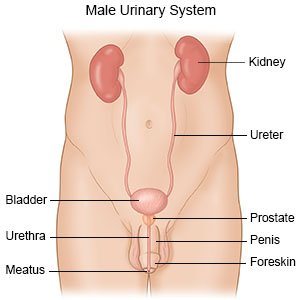Prostatic Urethral Lift
Medically reviewed by Drugs.com. Last updated on Aug 4, 2025.
What do I need to know about a prostatic urethral lift?
A prostatic urethral lift is a minimally invasive procedure to widen your urethra. The procedure is used to treat benign prostatic hyperplasia (BPH), or enlarged prostate. Small, permanent implants hold prostate tissue away from the sides of the urethra. This may make it easier for you to urinate.
 |
How do I prepare for this procedure?
- Your healthcare provider will tell you how to prepare. Your provider may tell you not to eat or drink after midnight on the day of your procedure. Arrange to have someone drive you home after you are discharged.
- Tell your provider about all your current medicines. Your provider will tell you if you need to start or stop taking any medicine for the procedure, and when to do so.
- Tell your provider about any allergies you have, including to medicines, anesthesia, stainless steel, nickel, or titanium.
- Your provider will tell you if you need tests before your surgery, and when to have them.
Related medications
What will happen during the procedure?
- You may be given local anesthesia and medicine to help you relax during the procedure. You may feel pressure or feel like you need to urinate during the procedure. You may be given general anesthesia instead to keep you asleep and pain free during the procedure.
- Your healthcare provider will insert a cystoscope through your urethra. A cystoscope is a thin tube with a small light and a camera on the end. The camera shows your prostate on a screen during the procedure.
- Your provider will put a device into your urethra through the cystoscope. The device is moved up to your prostate. This device is used to place 2 to 4 small implants into both sides of your prostate. The implants pull prostate tissue away to open your urethra.
What should I expect after the procedure?
Your healthcare provider will monitor you for any problems. You may be able to go home after your provider sees that you are okay.
- You may go home with a urinary catheter. This is a thin, flexible tube inserted into the bladder to drain urine. Your provider will tell you when the catheter can be removed.
- You may have pelvic pain, blood in your urine, or burning when you urinate. You may feel like you have to urinate urgently or more often. These effects are all expected and should get better within a few weeks.
- Your BPH symptoms should start to improve within a few weeks of the procedure.
What are the risks of a prostatic urethral lift?
You may leak urine or scar tissue may build up in your urethra. You may have trouble having sex, or develop a condition called retrograde ejaculation. This means semen goes into your bladder when you ejaculate. You may have blood clots in your urine that block your urethra. The procedure may not prevent your BPH symptoms from getting worse. You may need a different procedure or surgery to help with symptoms.
Care Agreement
You have the right to help plan your care. Learn about your health condition and how it may be treated. Discuss treatment options with your healthcare providers to decide what care you want to receive. You always have the right to refuse treatment. The above information is an educational aid only. It is not intended as medical advice for individual conditions or treatments. Talk to your doctor, nurse or pharmacist before following any medical regimen to see if it is safe and effective for you.© Copyright Merative 2025 Information is for End User's use only and may not be sold, redistributed or otherwise used for commercial purposes.
Further information
Always consult your healthcare provider to ensure the information displayed on this page applies to your personal circumstances.
